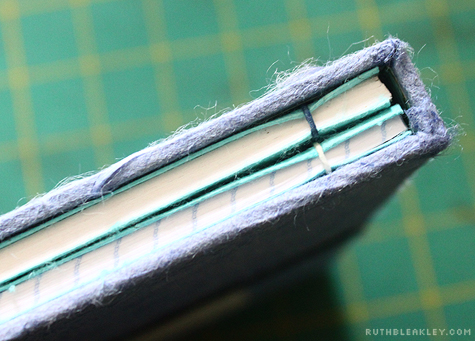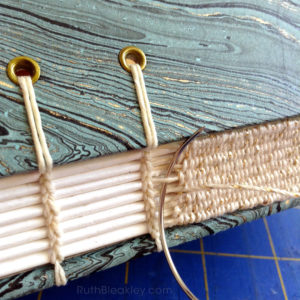I received a commission from a return customer who wanted to get another journal for his son Colin’s upcoming travels around asia. I wanted to make something that reflected both where he came from (Cape Cod) and where he was going (Asia). I really love complex stitching patterns and this Marionette Japanese Stab Binding Tutorial by Becca Hirsbrunner was just what I wanted.








Although she has tons of cool designs, my books weren’t very large, and they were vertically rather than horizontally oriented, so the stitching couldn’t extend too far into the book, or it wouldn’t open properly. This type of binding uses only one row of holes, and all the magic happens when you weave the thread together as you sew it. Each book was sewn with one long unbroken piece of waxed irish linen thread. I did have to stop and unlace it (twice!!) but that’s how you learn! 🙂
Colin is from Cape Cod so I wanted the colors of the book to remind him of home, with plenty of blues and cool waves paper on the inside. He’s traveling around Asia though, so I wanted the binding style to reflect the places he was visiting. It’s traditional to make cases for stab bound books, but they’re usually held together with a bone clasp. This one has elastic.
If you love complex bookbinding, check out my Handmade Books and Journals Pinterest board.
Also visit Becca’s blog Becca Making Faces for more great stab binding tutorials.









2 Comments
I would love a bit of info on the case you made. I am making a stab binding album for my daughter and future husband for thier wedding photos. I am also using the “Becca Making Faces” tutorial with that beautiful pattern. The handmade case looks quite beautiful. I think it would be a great addition to the album. You close the album with elastic or the holder?
Hi Paula! Thanks for commenting! The case closes with a piece of elastic – I bought a spool of it at a sewing store – honestly I can’t remember if the elastic is connected in some way to the case, or if it just loops around. It’s possible I made a slit in the back of the case with a chisel of the same width and then fed the elastic in, cut out a channel in the book board and then glued the waves paper on top to hide it. For the case construction I used book board the same width and height of my journals for the front and back covers, and book board for the spine. It’s been a while since I made this book, so hopefully those tips are helpful! Thanks for visiting my blog!
Ruth